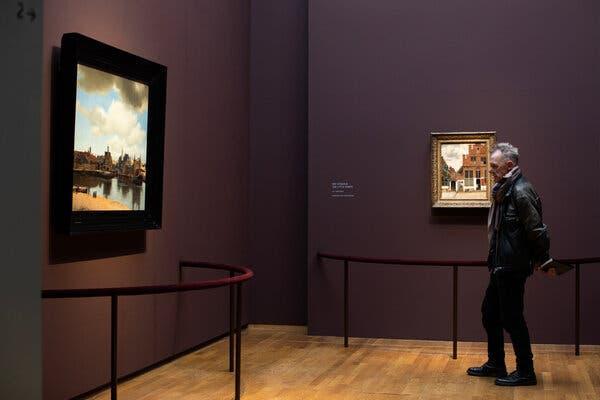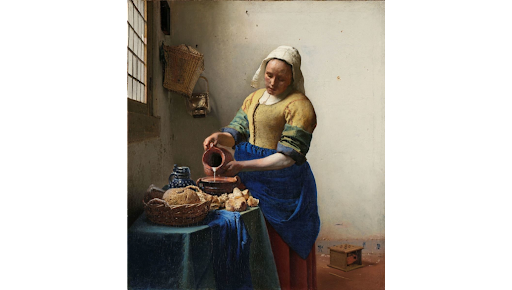The Dutch Master Who Kept His Ear: A Journey into the Life of Vermeer
An insight into the exhibition of the year – Vermeer, at the Rijkmuseum, Amsterdam.
By Emily Mills

There’s no question that you’ve come across the Dutch artist Van Gogh. I will be venturing into the mastery of another Dutch painter who was marginally less unhinged and died with his two ears still intact. His name was Vermeer.
Even if you haven’t heard the name Vermeer, Girl with a Pearl Earring will probably mean something. It is one of thirty seven remaining masterpieces of the 17th century Dutch master. Twenty eight of these works were displayed in a monumental exhibition at the Rijksmuseum of Amsterdam earlier this year. This triumph of an exhibition saw the largest ever number of his paintings in one place. It was likely a larger number than Vermeer ever saw at any one time. It broke records; 450,000 tickets sold out by the second day of the exhibition, and visitors from 113 countries transported themselves to the 1600s Dutch Golden age through his work. I was fortunate enough to be one of them.

I entered the exhibition alone. Something about a main character moment or whatever. Admittedly, this wasn’t the initial objective. I tried to push my friends to buy the rapidly selling tickets to this miraculous show, given we were to be in Amsterdam anyway. Alas, their leisurely planning wasn’t to be tolerated by the rapid sell-out time. Unless they were up for paying a mere £2,000 for resale, which they weren’t. While I was being transported to 17th century Dutch mastery through rich pigmented oil paints ruminating on the allegorical meanings of each painting, my companions were tackling some high-brow culture…known also as The Heineken Experience. This obviously made for a fantastic debrief. I was bubbling over with Dutch Golden Age inspired excitement while their bubbles had taken the more literal form of limitless Heineken beer.
From this you’ve probably judged that this was a boring decision on my part. And a fair judgement that might be. It’s not often you get the chance to sip free lager to your heart’s content while admiring the Amsterdam skyline. Perhaps the only occasions you find yourself looking at art is when dragged around by a family member or partner. It’s a test of endurance until you make a polite excuse to escape to the safety of the gift shop. Anything to stop them from droning on about the difference between impressionism and expressionism. Well, I’d like to reassure you that the Rijksmuseum’s logistical feat was anything but conceited.
The exhibition led visitors through a series of rooms painted in dark mauves and blues. Nearly all of Vermeer’s paintings have a hallmark feature of light entering from the left-hand side. The curatorial decision to accentuate this light with the dark walls was simple but effective. There’s a poetic simplicity that flows throughout his work. The subjects, often female, are absorbed in thought. The viewer is left to interpret the elusive emotions in each scene, or otherwise relish the picture-perfect intricacy. Vermeer’s attention to detail was of such quality that the art world speculates his use of the camera obscura – a precursor to modern day cameras – to create this realism. This is among other debates surrounding the Dutch master.

Of the thirty seven Vermeer paintings in existence, only thirty four are unanimously attributed to his hand. The contested oeuvres may have been done by a student of the artist, tasked with mimicking his style. All three of these were featured in the twenty eight piece exhibition.
This would have been twenty nine pieces, had the British not done what we do best – make excuses for not returning masterpieces that don’t belong to us. English Heritage refused to loan The Guitar Player to the exhibition, claiming the painting was too fragile. As it happens, they didn’t make this excuse when loaning it to the National Gallery in 2018. Despite many pleas from the Rijksmuseum and an assessment that any risk of damage would be negligible, the loan was refused.
Vermeer’s death in 1675 left his family in copious amounts of debt. In true Catholic fashion, the faith he converted to before marriage, he fathered fifteen children. Clearly this newfound zeal carried through into other areas of his life, as he was equally as partial to childbearing as he was to buying expensive oil paints. The bright white paint used for Girl with a Pearl Earring was sourced in the Peak District. Though necessary, it is paradoxical that Vermeer spent nearly the entirety of his life in his hometown of Delft yet had such international sources for his materials. While breathtaking, I felt that Girl with a Pearl Earring was humbled at the Rijksmuseum. Even Tracy Chevalier, author of the 1999 novel Girl with a Pearl Earring, which has film, play and radio adaptations, admitted that the subject painting was no longer her favourite. She revealed this following her visit to the 2023 exhibition. The small and unassuming painting was not placed on any pedestal nor given its own room but sat amongst others. It pushed viewers to relish the mastery of all his paintings without singling out that which people know the most about. Vermeer’s Girl with a Pearl Earring has been mimicked and reproduced throughout popular culture, but still was not the face of the exhibition. This was a particular feature of the exhibition that I appreciated, allowing me to enjoy the wonders of The Milkmaid and Allegory of the Catholic Faith. The Milkmaid spearheaded Vermeer’s series of paintings of portraits in domestic settings. The scene captures a vibrantly adorned subject who is motionless in her intent focus. There is a spellbinding contrast between her concentration and the pour of milk from the jug she holds. Perhaps the paintwork, or perhaps the mystical nonchalance of the character in this work enchanted me.

This exhibition was an impeccable celebration of an artist who was little known in his time. It is only in retrospect that Vermeer is recognised as one of the many wonders of the Dutch Golden Age, alongside others like Rembrandt who flourished in the era. He has finally received due credit for his sensational artistry with a triumphant exhibition. There is even a publicly accessible exploration of his works, narrated by Stephen Fry, on the Rijksmuseum website.
So, if ever given the choice, I’d urge you to choose Vermeer over beer.
